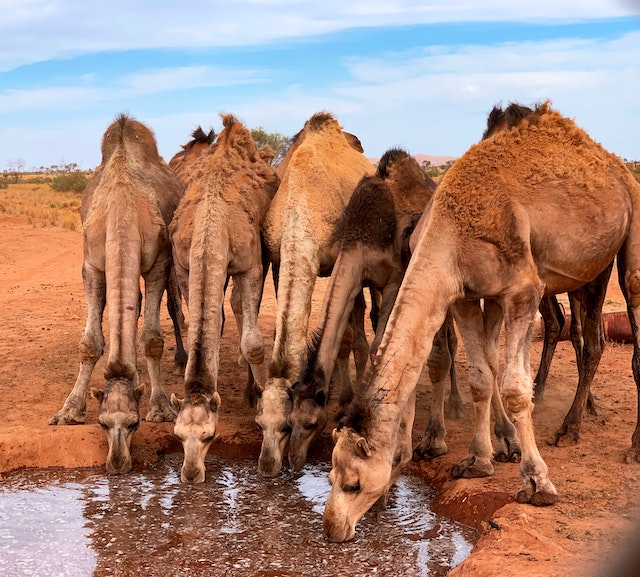
Why can camels go so long without water? They can survive for 15 days without water because they have several adaptations.
Camels are renowned for their ability to go long periods of time without drinking any water, which is one reason why they are so well suited to desert life. We can only survive for between three and five days without water. If we lose more than 15% of our body weight in fluids, we will usually die. We have never had to evolve to live in an environment where we can’t find water. If you look at a map of the world, most human settlements are near water and not in the desert. Camels can lose up to 40% of their body weight in fluids and survive.
So, why can camels go so long without water? The reason people usually give is that it is because camels can store a lot of water in their humps, but camels don’t actually store any water in their humps. The hump is a store of fat. Camels can use the fat for energy if they cannot get any food. The longer they go without food, the more fat they use from their hump, and the softer the hump becomes, deflating like a balloon. When the camel can eat again, the hump will reinflate as it fills with fat.
Camels have several adaptions that allow them to go without drinking for four times longer than we can. The first adaption is the amount they can drink and store in their bodies. Camels can drink over 110 liters of water in about 13 minutes. People used to think they stored the water in one of their stomachs, but they actually store it in their blood. Their blood becomes more fluid after they have drunk and then slowly thickens as they dehydrate. Camels are also able to extract water from the food they eat, so it may appear that they are not drinking, but if they are eating, they are taking in water. They can also turn some of the fat in their humps into water. Each hump contains approximately 35 kg of fat and when fat is metabolized in the body, 1 gram of fat can produce 1 gram of water. However, they cannot keep all of this water and a lot of it is lost through respiration.
The other adaptions that camels have are to conserve the water they have inside them. Camels don’t urinate very frequently and when they do it comes out like a thick syrup. Also, their feces are almost completely dry. Bedouins are able to burn camel dung as fuel because it is so dry. Camels don’t sweat, which saves water. Their thick coat insulates them from the heat and any water that they do sweat evaporates under their coat, so they don’t lose it. Their coat is a light color to reflect the sunlight and they have long thin legs to reduce their exposure to heat from the ground. The fat in their humps also keeps them cool, reducing the need to sweat. If a camel is shorn, it will have to sweat to keep cool.
The shape of camels’ blood cells also help them survive without water. Our blood cells are circular and when we get dehydrated, our blood thickens and the blood cells cannot move past each other, causing problems in the heart and organs. Camels have oval blood cells and they can slide past each other even when the blood is thicker. This also means they are better at storing water because their blood vessels don’t rupture when the camels drink enormous amounts of water very quickly. Camels also have kidneys and intestines that are very efficient at reabsorbing water.
Camels can go so long without drinking water because their bodies are extremely efficient at using and preserving the water that they have. Cows and other livestock lose between 20 and 40 liters of water a day while a camel only loses 1.3 liters. They have obviously evolved all of these adaptions to survive in areas that are very hot and don’t have a lot of water. There are other animals that can go without water for longer. Giraffes, for example, can survive for over 21 days without drinking any water. However, they get most of their water from the acacia leaves they eat, so they are technically getting water.
So, camels can go for long periods without water because of the way they control the amount of water they lose and because their body is set up to keep going with a low volume of water. And this is what I learned today.
Sources
https://www.quora.com/Can-a-camel-drink-53-gallons-200-liters-of-water-in-3-minutes
https://www.loc.gov/everyday-mysteries/zoology/item/how-much-water-does-a-camels-hump-hold/
https://www.britannica.com/story/do-camels-store-water-in-their-humps
https://en.wikipedia.org/wiki/Camel
https://animals.howstuffworks.com/mammals/camel-go-without-water1.htm
